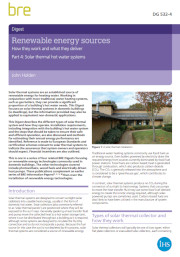Renewable energy sources: how they work and what they deliver: Part 4: Solar thermal hot water systems DG 532 4
BRE (Building Research Establishment) is an independent, research-based consultancy, testing and training organisation, operating in the built environment and associated industries.
Renewable energy sources: how they work and what they deliver: Part 4: Solar thermal hot water systems (DG 532/4) was written by John Holden and published by BRE on 5 December 2014.
This is one in a series of four BRE Digests focusing on renewable energy technologies commonly used in domestic buildings. They complement an earlier series of BRE Information Papers that cover the installation of renewable energy technologies.
The other technologies covered include:
- Photovoltaics.
- Wood fuels.
- Electrically-driven heat pumps.
Solar thermal systems are designed to convert sunlight (solar radiation) into useable heat energy, usually in the form of domestic hot water. Solar collectors (also commonly referred to as solar thermal panels) are positioned where they will be exposed to the sun’s rays. Generally speaking, a heat transfer fluid and pump move the collected heat to a hot water storage tank, where it can be distributed throughout a building as required, although some systems are designed to circulate the fluid by convection and so do not incorporate a pump. Working together with more traditional water heating systems, such as gas boilers, this can provide a significant proportion of a building’s hot water needs.
DG 532/4 focuses on solar thermal systems in dwellings. The information provided may also be applied to equivalent non-domestic applications. It describes:
- Different types of solar thermal system and how they operate.
- Installation requirements, including integration with hot water systems.
- The steps that should be taken to ensure safe and efficient operation.
- Methods for estimating annual energy performance.
Reference is made to European Standards and certification schemes to indicate the assurances that system owners and operators should expect. Financial incentives are also outlined.
Its contents include:
- Introduction.
- Types of solar thermal collector and how they work.
- Maintenance.
- System design considerations.
- Standards and certification.
- Conclusion.
- References.
[edit] Find out more.
[edit] Related articles on Designing Buildings Wiki
- BRE articles on Designing Buildings Wiki.
- BRE Buzz articles on Designing Buildings Wiki.
- BRE Buzz.
- BRE National Solar Centre.
- BREEAM.
- Large scale solar thermal energy.
- Heat pump.
- Odeillo solar furnace.
- Photovoltaics.
- Renewable energy sources: how they work and what they deliver: Part 3: Electrically driven heat pumps DG 532 3.
- Renewable energy.
- Solar photovoltaics.
- Solar thermal systems
- Solar-assisted heat pump.
- Wind loads on roof-mounted photovoltaic and solar thermal systems DG 489.
Featured articles and news
RTPI leader to become new CIOB Chief Executive Officer
Dr Victoria Hills MRTPI, FICE to take over after Caroline Gumble’s departure.
Social and affordable housing, a long term plan for delivery
The “Delivering a Decade of Renewal for Social and Affordable Housing” strategy sets out future path.
A change to adoptive architecture
Effects of global weather warming on architectural detailing, material choice and human interaction.
The proposed publicly owned and backed subsidiary of Homes England, to facilitate new homes.
How big is the problem and what can we do to mitigate the effects?
Overheating guidance and tools for building designers
A number of cool guides to help with the heat.
The UK's Modern Industrial Strategy: A 10 year plan
Previous consultation criticism, current key elements and general support with some persisting reservations.
Building Safety Regulator reforms
New roles, new staff and a new fast track service pave the way for a single construction regulator.
Architectural Technologist CPDs and Communications
CIAT CPD… and how you can do it!
Cooling centres and cool spaces
Managing extreme heat in cities by directing the public to places for heat stress relief and water sources.
Winter gardens: A brief history and warm variations
Extending the season with glass in different forms and terms.
Restoring Great Yarmouth's Winter Gardens
Transforming one of the least sustainable constructions imaginable.
Construction Skills Mission Board launch sector drive
Newly formed government and industry collaboration set strategy for recruiting an additional 100,000 construction workers a year.
New Architects Code comes into effect in September 2025
ARB Architects Code of Conduct and Practice available with ongoing consultation regarding guidance.
Welsh Skills Body (Medr) launches ambitious plan
The new skills body brings together funding and regulation of tertiary education and research for the devolved nation.
Paul Gandy FCIOB announced as next CIOB President
Former Tilbury Douglas CEO takes helm.
UK Infrastructure: A 10 Year Strategy. In brief with reactions
With the National Infrastructure and Service Transformation Authority (NISTA).
























